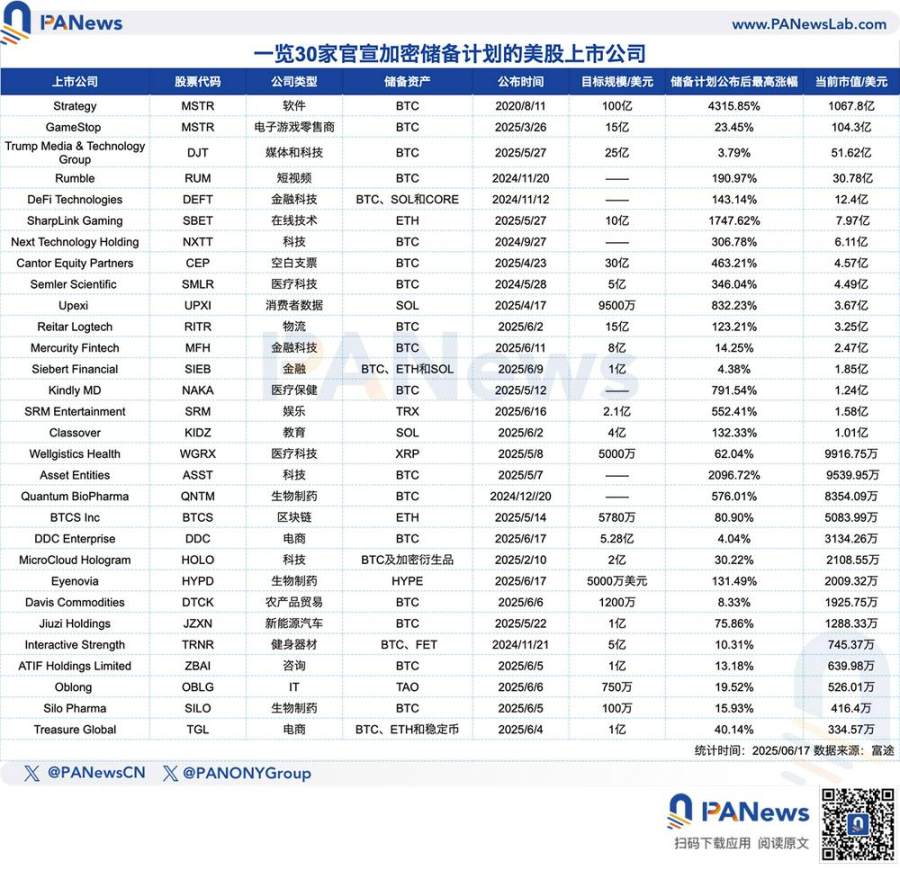30 U.S.-listed companies follow the trend of "micro-strategy effect": small and medium-sized market capitalisation has become the main force of crypto reserves, and the stock price has soared by 438% on average
Written by: NancyFollowing
the gradual failure of traditional crypto methods such as brand rebranding, buyback and burning, a more capital-based cryptocurrency stock model has begun to emerge, and has even become a new narrative engine for crypto projects.
From finance to technology, from healthcare to entertainment, more and more listed companies are following the path of micro-strategy (Strategy) and incorporating crypto assets such as BTC, ETH, SOL, and TRX into their balance sheets, starting a capital game of valuation repricing. In this article, PANews counts 30 U.S.-listed companies that have officially announced crypto reserve plans.
 – >
– >
From financial strategy to valuation logic, small and mid-cap companies collectively replicate the "micro-strategy effect".
As a pioneer of coin equity strategy, Strategy was the first to include Bitcoin on its balance sheet back in August 2020, a radical move that was seen as an alternative financial experiment at the time. Five years on, however, what was once a niche strategy is evolving into a mainstream narrative path that companies across industries are competing to emulate. More and more companies, especially small and medium-capitalisation listed companies, have begun to incorporate crypto assets into the reserve system, trying to reconstruct their valuation logic through "crypto reserves + capital market leverage".
Judging from the current statistics of 30 U.S. listed companies, in addition to technology and fintech companies represented by Strategy, BTCS, DeFi Technologies, etc., traditional industries such as healthcare, biopharmaceuticals, e-commerce, education, new energy vehicles, agricultural product trade, entertainment and media have also gradually included crypto assets in the scope of asset allocation.
Most of these companies share challenges such as sluggish core business growth, stagflation in valuations and illiquidity, such as SharpLink Gaming, Semler Scientific, Kindly MD, Quantum BioPharma and Silo Pharma. Against the backdrop of blocked traditional paths, the deployment of crypto assets is both a financial strategy and an attempt to reshape the narrative of the capital market. Take SharpLink Gaming as an example, the company was on the verge of delisting due to unsatisfactory performance, and after announcing Ethereum as a major reserve asset at the end of 2024, it quickly obtained a financing agreement of up to $425 million, and the market attention rose sharply, and the market value soared from $2 million to tens of millions of dollars, and the valuation logic was completely reconstructed.
The current crypto asset reserve structure is still dominated by Bitcoin. According to the statistical results, about 20 listed companies have explicitly included BTC in their asset baskets, including Strategy, GameStop, Trump Media, Rumble, Next Technology Holding, Cantor Equity, and others. Ethereum has gradually become the second most popular reserve asset, with companies such as BTCS, Treasure Global, and SharpLink Gaming choosing to allocate ETH. Some companies are opting for a more diversified portfolio strategy, such as DeFi Technologies, Siebert Financial, Interactive Strength, etc., to build hybrid crypto reserves with Bitcoin, Ethereum and other tokens, or to find a balance between risk resilience and market speculation potential.
From the perspective of time, although Strategy launched the Bitcoin reserve as early as 2020, there were few responders in the following years, until the fourth quarter of 2024, when the price of Bitcoin returned to a high level, and Strategy's stock price rose sharply, driving the yield of its coin stock model to skyrocket, and the wave of crypto reserves entered a period of intensive explosion.
Most of these follow-up companies have market capitalisations in the $100 million to $1 billion range, with reserve targets ranging from a few million to billions of dollars. Among them, Strategy's Bitcoin reserve target is as high as $10 billion, Cantor Equity's is $3 billion, and Trump Media's is $2.5 billion. It is worth noting that some companies' reserve targets are much higher than their market capitalisation, creating a significant risk leverage effect, which can stimulate market speculation and expectations, but also exacerbate the risk of valuation bubbles.
Looking at stock price performance, most companies experienced a short-term strong burst after the release of their reserve plans, with an average maximum increase of 438.53%. Among them, Strategy has risen by 4315.85% since its first release; 2096.72% for Asset Entities; SharpLink Gaming 1747.62%; Kindly MD has a rating of 791.54%. However, there are also many companies whose stock prices have not changed much, such as SIEB, SILO, DTCK, and the market may lack confidence in their continued execution ability and narrative credibility.
Of course, in addition to the act of reserve itself, some companies further amplify their market effect by obtaining strategic support from crypto giants or well-known capital. For example, SharpLink Gaming is strategically bound to well-known institutions such as ConsenSys and has been endorsed by the Ethereum ecosystem. Cantor Equity Partners' merger with Twenty One Capital to launch a BTC reserve strategy, backed by Tether, SoftBank and Brandon Lutnick, son of the U.S. Secretary of Commerce; SRM Entertainment plans to use TRX as its core reserve asset and announced the support of TRON founder Justin Sun, who even surpassed Alibaba and Tencent in trading volume on June 17. The injection of these crypto backgrounds brings enterprises the right to speak in the ecosystem beyond financial allocation, and enhances the linkage between their on-chain assets and the capital market.
It can be seen that more and more listed companies are no longer satisfied with only including mainstream crypto assets such as Bitcoin and Ethereum in their balance sheets, but have begun to allocate emerging crypto assets such as XRP, SOL, TRON and HYPE. In the future, it may become a new trend for crypto projects to build reserves through lobbying or looking for listed companies.
On the whole, the collective influx of listed companies into the field of crypto reserves is ostensibly a recognition of crypto assets, but behind it is the skilful use of capital market mechanisms, especially in the context of weak performance and limited market value. In the short term, this provides a new financing path and narrative exit for many small and medium-sized companies; In the long run, whether the reserve structure of enterprises is sustainable, whether the value of assets is valued, and whether the on-chain behaviour is transparent will become the key to determine whether this trend can develop healthily.
Cannibalizing the "cake" of listed companies? Market risk and manipulation controversy go hand in handWith
the rapid spread of the trend of companies including crypto assets in their balance sheets, it has also triggered widespread controversy in the market about risk management, market manipulation and institutional suitability.
Bitcoin advocate and Bitcoin Magazine CEO David Bailey sees this trend as a paradigm shift in the capital structure. He bluntly stated, "Every time one of our bitcoin vault reserve companies is included in an index, there is a traditional company that doesn't hold bitcoin is kicked out. I'm sorry, but your liquidity has now become Bitcoin liquidity. Join or be eliminated."
Blockstream CEO Adam Back issued a similar warning, "Bitcoin vault reserves are eating away at the cake of public companies. If you ignore the biggest arbitrage opportunity of the century, the reallocation of capital will eventually leave you behind. It's not really an 'option.'"
Haseeb Qureshi, managing partner at Dragonfly, believes that in every market cycle, founders chase hot money flows. In the last cycle, the issuance of tokens was a hot spot because the crypto capital market was extremely active; In this cycle, the introduction of tokens into the stock market (similar to the financial company model) has become a new trend. He pointed out that hot money never stays in one place for long, which is why the treasury company will not be the ultimate model, but he expects the trend to continue for another 1-2 years until the heat subsides.
As for the risk management of crypto reserve companies, Strategy CEO Michael Saylor advises, "It's not a good idea to publish on-chain proof of reserves." He noted that making wallet addresses public could pose a long-term tracking risk for institutions. Separate reserve information is meaningless without disclosing liabilities audited by the Big Four accounting firms.
Binance founder CZ also stressed on social media that "these companies are taking risks. Every company takes risks. Risk is not an either/or binary like 0 or 1. Risk is a range from 0 to 100. With the right balance, you'll be able to achieve the best risk/return on investment (risk/ROI) ratio that suits you best. Risks can/must be managed. Not taking a risk is a risk in itself."
Coinbase CEO Brian Armstrong revealed in a Q&A that he considered putting up to 80% of his balance sheet into Bitcoin, but ultimately decided to abandon this radical plan "because it could ruin the company." He explained that in the early stages, if the BTC price suddenly falls, the company's funding runway can plummet from 18 months to 10 months, affecting fundraising and business development. He further noted that the company does hold Bitcoin on its balance sheet and currently holds about 25% of its net cash holdings in cryptocurrency. "We're not going to put 80 percent into it, I think that's too risky."
As for some small and medium-sized listed companies announcing the allocation of large reserves to altcoins, Matthew Sigel, head of digital assets at VanEck, pointed out that these companies claim to be buying hundreds of millions of dollars in tokens (such as XRP and SOL), and these so-called reserve plans are likely to be just a means to drive up the stock prices of small-cap companies, many of which are trading on the NASDAQ. "A lot of it was insiders trying to pump up the shipment, and if the market cap was negligible and no new investors were disclosed, I would have decided it was a scam."
In response to the expansion of this leveraged model, digital asset bank Sygnum warned in its latest report that companies such as Strategy are deviating from the financial strategies of traditional companies by continuing to increase their holdings of bitcoin through leveraged methods such as issuing bonds. This practice may weaken the applicability of Bitcoin as a central bank reserve asset, and excessive concentration of holdings may lead to a decrease in market liquidity and increased price volatility, which may affect the allocation willingness of central banks and other institutions.
Max Keiser, an early advocate for Bitcoin, also questioned the emerging Bitcoin finance companies that mimicked Strategy's line, arguing that they have yet to be tested by a true bear market. He stressed, "Saylor never sold Bitcoin during the bear market, but continued to buy it. Only those companies that have held their positions in the toughest times in the market can be called true believers in the Bitcoin vault."
In general, crypto assets are rising from financial reserves to corporate strategies, but the success or failure of the strategy will ultimately be decided by the market.
